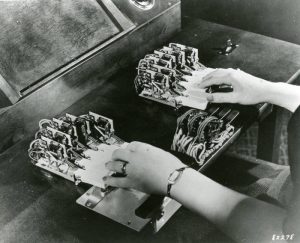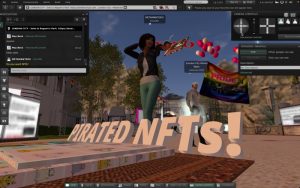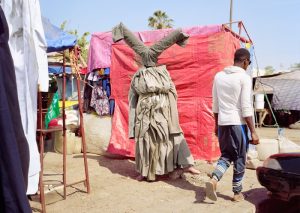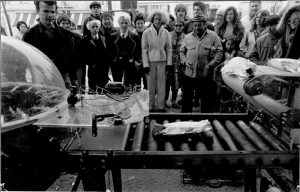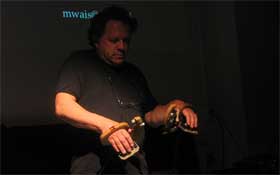 Now i’m back home, i can finally sum up some mental strength and blog the rough notes i took during Michel Waisvisz‘ fascinating presentation at the Mobile Music Workshop last week. One of the co-founders of STEIM which co-hosted the MMW, Waisvisz is a composer/performer of live electronic music, who has invented new ways to achieve physical touch with electronic music instruments, for example by literally touching the electricity inside the instruments. Forget all i’ve ever written about my favourite artist/researcher/designer/nightcream, this guy is officially my new hero. He illustrated his quest to find and develop a physical relationships with electronic musical instrument by performing an improvised electronic piece using The Hands, an interface he conceived in the early 1980s. The aluminum plates worn like some kind of gloves contain touch sensitive keys, thumb pressure sensors, and tilt and proximity sensors. Both large overt body motions and small fingertip control influence the music. His demo showed how the sound and words he made in the microphone could be transposed, scratched and re-arranged. If you pronounce a sentence very clearly you can navigate details of the words on the go.
Now i’m back home, i can finally sum up some mental strength and blog the rough notes i took during Michel Waisvisz‘ fascinating presentation at the Mobile Music Workshop last week. One of the co-founders of STEIM which co-hosted the MMW, Waisvisz is a composer/performer of live electronic music, who has invented new ways to achieve physical touch with electronic music instruments, for example by literally touching the electricity inside the instruments. Forget all i’ve ever written about my favourite artist/researcher/designer/nightcream, this guy is officially my new hero. He illustrated his quest to find and develop a physical relationships with electronic musical instrument by performing an improvised electronic piece using The Hands, an interface he conceived in the early 1980s. The aluminum plates worn like some kind of gloves contain touch sensitive keys, thumb pressure sensors, and tilt and proximity sensors. Both large overt body motions and small fingertip control influence the music. His demo showed how the sound and words he made in the microphone could be transposed, scratched and re-arranged. If you pronounce a sentence very clearly you can navigate details of the words on the go.
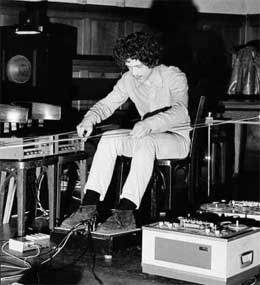 In the ’60s, when he was a teenager he would do some musical experiments with his brother: putting a piano upside down and playing the isntrument just by touching his strings or they would stick a trumper in a bucket of soap and discover interesting sounds.
In the ’60s, when he was a teenager he would do some musical experiments with his brother: putting a piano upside down and playing the isntrument just by touching his strings or they would stick a trumper in a bucket of soap and discover interesting sounds.
He showed us a fantastic picture of him becoming literally a tape reading machine using “The TapePuller” instrument (image on the right). He was live sampling, scratching 2 tape heads using footpedals. He’d pull one forward with a foot to create music while rewinding the other tape unheard of the public with the other foot.
He discussed his fascination for the VC3, a synthetiser that can be used without a keyboard, adding that the idea of the keyboard comes from church music and thus carries a series of connotations with it. He bought a Putney VC3 synthesiser, opened its back and put his fingers inside. He thus used the body to extend the circuitry and modified the sound in ways he found interesting. The manipulations gave him the feeling that the sound was floating in the room and that he could grab it. He decided that instead of opening the instrument back he should better customize it. This was the inspiration for what later became the CrackleBoxes. he was fascinated by the idea of a human being who is turned into a variable electronic conductor/resistor, and a thinking [wet] element of the musical instrument. This idea of changing the circuitry by using body conductivity has now been patented by Microsoft!
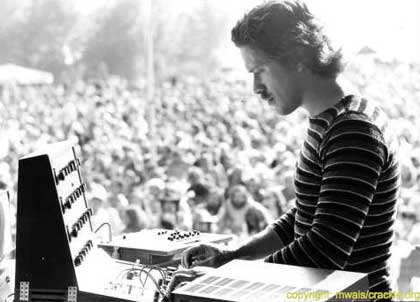
The theremin, developed by Russian inventor Léon Theremin in 1919, was the first musical instrument that really engaged the body.
In 1973, Waisvisz arrived at STEIM and worked on the Crackleboxes, handheld instruments based on the same principle of body conductivity. Still in the mid ’70s, he took STEIM on the road for a Cracko exhibition in a gallery in the South of France.
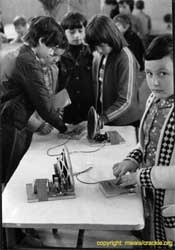
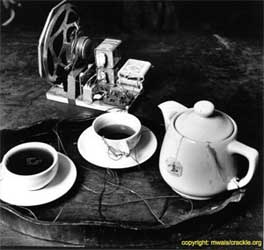
All sort of Crackle objects could be manipulated by children. It was such a success that many other exhibitions followed. Among the artefacts (some of which are re-invented by young interaction designers and shown today at events such as the Milan Furniture fair) shown were phones that distorts your voice according to the strength you use to squeeze the receiver; a musical bike which generator was connected to speakers instead of the lights; a series of connected crackle boxes that makes melodies when you pour some tea in the cups; a cuckoo clock producing scratchiy sounds, etc. The favourite being a Cracko Jail that only opens when you find the right musical combination. This cracko mania gave way to the “Crackle family of the future” who creates music by eating out of empty plates. The sounds came from the loudspeakers in the pots. Changes of sound were controlled by putting the spoons and forks deeper in their mouths. Their children created music by pouring tea in cups. The tea comming out of the pot connected the circuits of the pot and the cups; the amount of tea influenced the musical sounds.
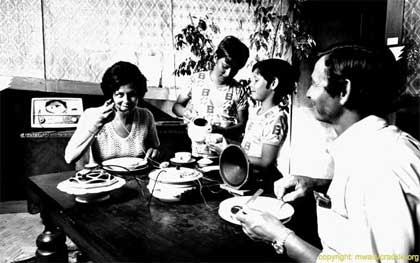
In 1981, he was performing the first part of a concert of Brian Eno in Bologna. He thought he couldn’t compete so he unleashed a robot among the public on the Piazza Magiore. The robot was running around and transmitting music among the audience.
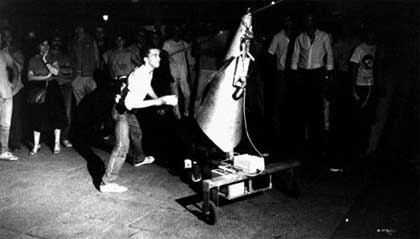
He mentioned several projects that investigate this (still under-developed) physical relationship with musical instruments: Jon Rose’s Hyperstring bow; Nicolas Collins‘ “trombone-propelled electronics”, the Lady’s Glove by Laetitia Sonami.
Another of Waiswizs’ famous projects is the Web where each thread in the spiderweb-like instrument is a sensor. People can play it and manipulate the timbre in a very intuitive way by grabbing the strings. The first prototype is still at the Science Museum in London. He made a version for kids where each thread corresponds to the sound of an animal. According to the way you grab the thread, the sound is modulated and morphs toward the sound of a human being imitating that animal.
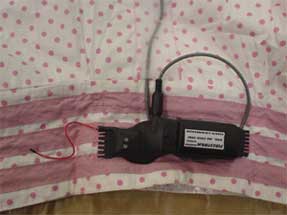
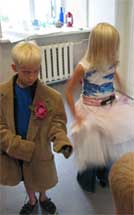
A last work he mentioned is Kristina Andersen‘s’ensemble, a suitcase full of sounds and clothes. Seven garments are fitted with wireless sensors that control sound samples and their modifiers in real time. The sensors are fitted in the garments in such a way that the function of the sensor is conceptually supported by the form-factors of the garment. The dress holds an accelerometer, the hat tilt switches etc. The garments are using hacked and modified game-pads as wireless signal carriers (images).
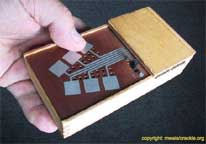
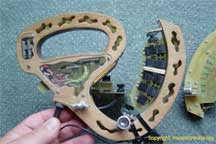 A Cracke Box and The Hands
A Cracke Box and The Hands
Many people are now experimenting with touch interfaces. Waisvizs’s own research is more “crude.” There are now better tools and better softwares around so he and STEIM are moving into a new research area which explores the way effort and energy can be harness to create new musical experiences.

